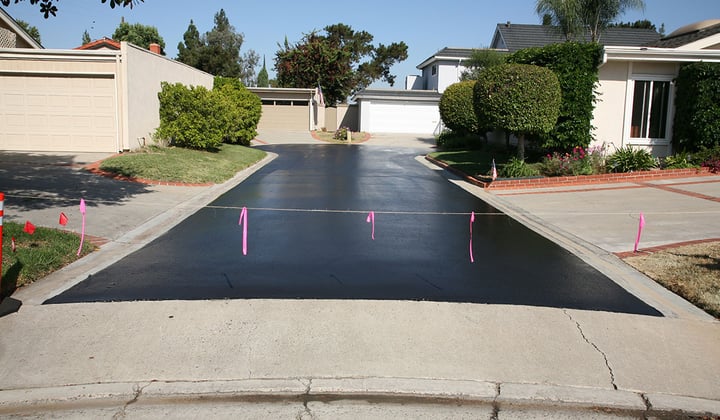Transform Your Property's Aesthetic appeals: Commercial Parking Area Paving and Asphalt Sealing Solutions
Transform Your Property's Aesthetic appeals: Commercial Parking Area Paving and Asphalt Sealing Solutions
Blog Article
Warm Mix Asphalt: A Sustainable Solution for Pavement
Hot Mix Asphalt (HMA) has arised as a leading sustainable selection for sidewalk solutions, providing a myriad of ecological benefits and innovative innovations. Its ability to decrease and reuse products energy consumption offers a compelling situation for its adoption in road construction tasks. Moreover, the lasting efficiency and durability of HMA make it a preferred choice for framework advancement. As the need for green building practices grows, discovering the subtleties of HMA's sustainability can give important insights into the future of sidewalk remedies.
Environmental Advantages of Warm Mix Asphalt

Moreover, Hot Mix Asphalt assists to alleviate metropolitan warm island impacts. Its dark color soaks up sunlight, lowering the amount of heat showed back into the atmosphere compared to lighter-colored sidewalks. This can reduce ambient temperature levels in city locations, decreasing the demand for cooling and eventually lowering energy consumption.
Furthermore, Warm Mix Asphalt adds to boosted stormwater administration. Its porous nature enables water to charge and penetrate the pavement groundwater products, reducing runoff and the danger of flooding. These ecological benefits make Warm Mix Asphalt a lasting option for leading highways and roads.
Energy Performance in HMA Manufacturing
Is power effectiveness an important variable in the production of Hot Mix Asphalt (HMA)? Power plays a considerable role in the production of HMA, affecting both expense and environmental sustainability. One vital element of energy performance in HMA production is the use of cozy mix asphalt (WMA) technologies.
Moreover, improvements in plant technologies have caused more energy-efficient HMA manufacturing processes. Modern plants are developed with attributes like recycled asphalt sidewalk (RAP) handling abilities, effective heater systems, and improved insulation, all adding to power financial savings. By enhancing energy use in HMA production, the market can decrease its carbon impact while keeping top quality pavement products. Power effectiveness is, consequently, an essential factor to consider in making sure the sustainability of Hot Mix Asphalt production.
Recyclability of Hot Mix Asphalt
The recyclability of Warm Mix Asphalt (HMA) is a crucial facet of its sustainability and long-lasting environmental impact. HMA is just one of one of the most recycled materials in the United States, with over 100 million heaps of reclaimed asphalt pavement (RAP) being recycled annually in new sidewalk building and construction. Reusing HMA provides a number of ecological benefits, such as reducing the demand for virgin materials, lowering energy intake throughout manufacturing, and decreasing the amount of waste sent out to landfills.
The process of reusing HMA entails crushing the existing sidewalk, squashing it right into smaller sized pieces, and blending it with brand-new aggregate and asphalt binder to develop a recycled mix. Overall, the recyclability of HMA plays a significant function in promoting sustainable techniques within the pavement industry.

Long-Term Performance of HMA
Asphalt pavements show longevity and strength over a prolonged duration, mirroring the lasting performance of Hot Mix Asphalt (HMA) The long life of HMA can be credited to its capability to withstand heavy traffic loads, rough weather, and the effects of aging. Studies have actually revealed that properly designed and correctly created HMA pavements can last for twenty years or more with routine upkeep. The trick to making the most of the long-term performance of HMA hinges on utilizing top quality products, following finest techniques in building and construction, and executing efficient maintenance strategies. Proper water drainage, regular inspections, and prompt repair work are crucial for maintaining the structural honesty of HMA sidewalks gradually. Furthermore, advancements in HMA modern technology, such as using polymer-modified binders and warm mix asphalt, have better boosted the resilience and durability of HMA sidewalks. By focusing on quality construction and maintenance practices, HMA remains to prove itself as a sustainable and cost-efficient solution for lasting pavement framework.

HMA: Toughness and Sustainability
Demonstrating both longevity and sustainability, Hot Mix Asphalt (HMA) has a fantastic read ended up being a cornerstone in the building and construction of lasting pavement infrastructures - commercial parking lot paving. HMA's toughness originates from its ability to stand up to heavy loads, severe weather problems, and high web traffic volumes, making it a reliable option for roads, highways, and airport terminal runways. The structure of HMA, which normally includes aggregates, binder, and filler, plays a crucial role in improving its longevity and resistance to tear and put on
Moreover, HMA's sustainability hinges on its recyclability and energy-efficient production process. The ability to reuse reclaimed asphalt sidewalk (RAP) in brand-new HMA mixes lowers the demand for virgin products and minimizes the environmental influence of pavement building and maintenance. Additionally, why not look here the power effectiveness of generating HMA hinges on its lower mixing temperature levels contrasted to other sidewalk materials, bring about decreased energy usage and greenhouse gas emissions.
Final Thought
In verdict, hot mix asphalt (HMA) supplies a lasting remedy for pavement with its eco pleasant characteristics. HMA's recyclability, energy effectiveness in production, and long-lasting longevity make it an environment-friendly option for road building and construction.
HMA is one of the most recycled products in the United States, with over 100 million heaps of recovered asphalt sidewalk (RAP) being reused each year in new sidewalk building.The procedure of recycling HMA includes grating the Learn More existing pavement, squashing it right into smaller items, and mixing it with brand-new accumulation and asphalt binder to develop a recycled mix.Asphalt pavements show toughness and strength over an extended period, mirroring the long-lasting performance of Hot Mix Asphalt (HMA) In addition, improvements in HMA technology, such as the use of polymer-modified binders and cozy mix asphalt, have even more enhanced the resilience and longevity of HMA sidewalks. The ability to reuse recovered asphalt sidewalk (RAP) in new HMA mixtures minimizes the demand for virgin materials and reduces the environmental influence of sidewalk building and upkeep.
Report this page